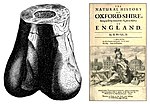Chipping Norton Formation
| Chipping Norton Formation | |
|---|---|
| Type | Geological formation |
| Location | |
| Country | |
The Chipping Norton Formation is a geological formation in Europe. It dates back to the Middle Jurassic.[1]
Vertebrate fauna
The so-called "Scrotum humanum" remains may have come from this formation.[1]
Color key
|
Notes Uncertain or tentative taxa are in small text; |
| Dinosaurs reported from the Chipping Norton Formation | ||||||
|---|---|---|---|---|---|---|
| Genus | Species | Location | Stratigraphic position | Material | Notes | Images |
|
Indeterminate[2] |
|
Actually indeterminate ornithischian remains.[3] |
   | |||
|
C. giganteus[5] |
|
Actually indeterminate sauropod remains.[5] | ||||
|
Indeterminate[4] |
Actually indeterminate sauropod remains.[5] | |||||
|
Indeterminate[4] |
Oxfordshire remains later found to be from an indeterminate theropod.[5] | |||||
|
O. vetustus[5] |
|
Actually indeterminate stegosaur remains.[5] | ||||
|
Indeterminate[6] |
|
Actually indeterminate ornithischian remains.[3] | ||||
|
Indeterminate[3] |
|
Previously assigned to Stegosaurus sp. and (tentatively) Omosaurus vetustus.[3] | ||||
|
S. cuvieri[5] |
|
"Vertebrae [and] limb elements."[7] |
Actually indeterminate theropod remains.[5] | |||
See also
Footnotes
- ^ a b Weishampel, David B; et al. (2004). "Dinosaur distribution (Middle Jurassic, Europe)." In: Weishampel, David B.; Dodson, Peter; and Osmólska, Halszka (eds.): The Dinosauria, 2nd, Berkeley: University of California Press. Pp. 538–541. ISBN 0-520-24209-2.
- ^ a b Listed as "cf. Alocodon sp." in "10.3 Gloucestershire, England; 2. Chipping Norton Formation," in Weishampel, et al. (2004). Page 538.
- ^ a b c d e f g h i j "10.3 Gloucestershire, England; 2. Chipping Norton Formation," in Weishampel, et al. (2004). Page 538.
- ^ a b c d "10.3 Gloucestershire, England; 2. Chipping Norton Formation" and "10.11 Oxfordshire, England; 2. Chipping Norton Formation," in Weishampel, et al. (2004). Pages 538,540.
- ^ a b c d e f g h i j k l m n o "10.11 Oxfordshire, England; 2. Chipping Norton Formation," in Weishampel, et al. (2004). Page 540.
- ^ a b Listed as "cf. Phyllodon sp." in "10.3 Gloucestershire, England; 2. Chipping Norton Formation," in Weishampel, et al. (2004). Page 538.
- ^ "Table 4.1," in Weishampel, et al. (2004). Page 78.
References
- Weishampel, David B.; Dodson, Peter; and Osmólska, Halszka (eds.): The Dinosauria, 2nd, Berkeley: University of California Press. 861 pp. ISBN 0-520-24209-2.
